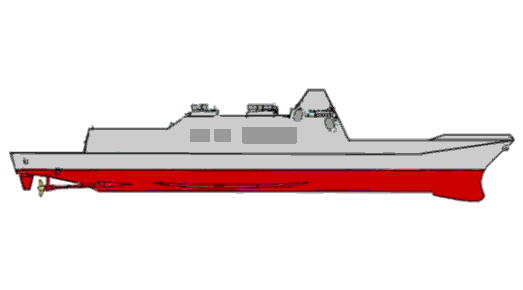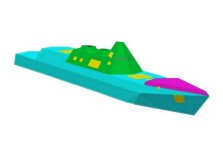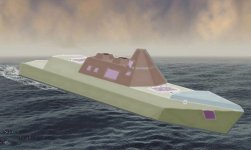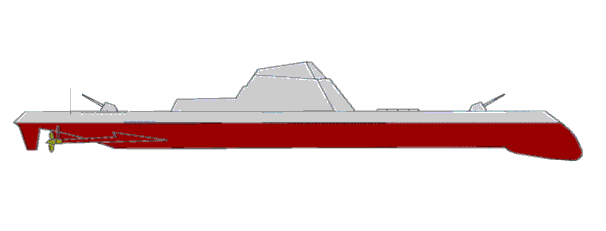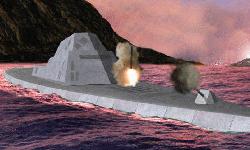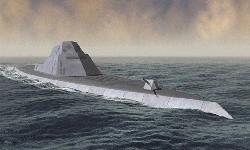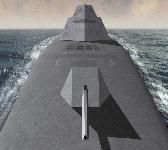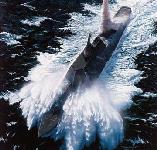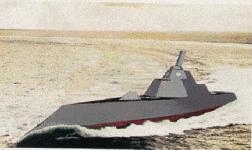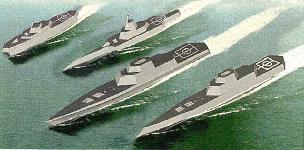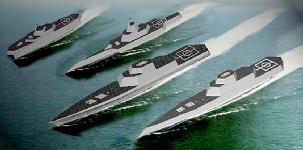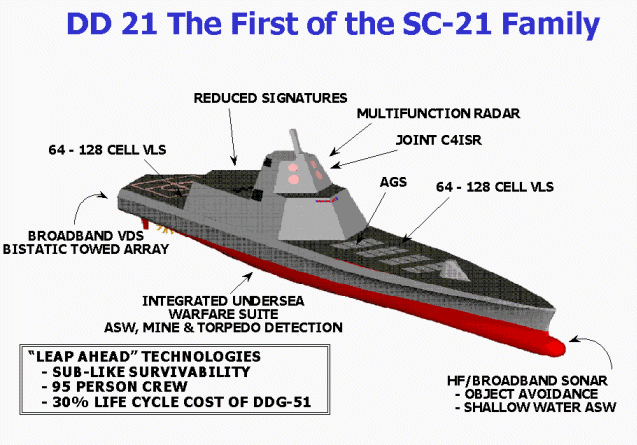




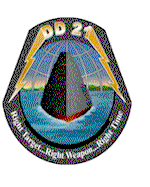 The DD-21 Zumwalt-class Land Attack Destroyer replaces the DD 963 and FFG 7 Classes of destroyer and frigate in today's inventory. The DD 21 System will provide an advanced level of land attack in support of the ground campaign and contribute to naval, joint and combined battlespace dominance in littoral operations. The DD 21 will be a true fleet destroyer, capable of handling any mission that a Fleet commander might ask, from key wartime missions in land attack and undersea warfare to the equally important presence missions, noncombatant evacuations, escort,
and diplomatic missions that have been closely associated with Navy destroyers for almost a century.
The DD-21 Zumwalt-class Land Attack Destroyer replaces the DD 963 and FFG 7 Classes of destroyer and frigate in today's inventory. The DD 21 System will provide an advanced level of land attack in support of the ground campaign and contribute to naval, joint and combined battlespace dominance in littoral operations. The DD 21 will be a true fleet destroyer, capable of handling any mission that a Fleet commander might ask, from key wartime missions in land attack and undersea warfare to the equally important presence missions, noncombatant evacuations, escort,
and diplomatic missions that have been closely associated with Navy destroyers for almost a century.
Like today's Arleigh Burke-class guided-missile destroyers, DD 21 will be a multi-mission ship, capable of providing forward presence and deterrence, and operating as a vital part of naval, joint and combined maritime forces to gain battlespace dominance in littoral operations. But unlike today's destroyers, DD 21's primary mission will be land attack support for ground forces. Armed with 5-inch/62 extended range guided munitions and 155mm Howitzers, the ship will provide naval gunfire support up to 100 miles inland. A land attack missile system will extend support between 100 and 200 miles. Tactical Tomahawk missiles will be able to reach targets from 200 to 1,600 nautical miles.
DD 21 will have the most advanced undersea warfare combat systems ever installed on a surface combatant. The ship's hangar will house attack helicopters as well as a system of unmanned aerial vehicles (UAV). In concert with other ships, DD 21 will contribute surveillance and force to establish and maintain local air superiority.
The DD 21 program emphasizes more than just improved offensive and defensive capabilities. Because DD 21's design will incorporate only the most advanced systems and materials on the market today, ships of the class can remain battle-ready with minimal maintenance and greatly reduced manpower. Design characteristics such as submarine-like survivability and a significantly reduced radar signature, achieved through a fully integrated topside design, will significantly expand the mission of the surface combatant.
As with previous destroyer designs, DD 21 will be focused on the key mission areas facing the nation and the Navy during its design phase. The Navy believes it needs a destroyer that is capable of exceptional performance in the littoral regions of the world and one that can provide significant support to forces ashore. As a result, DD 21 must excel in mission areas that include land attack and maritime dominance. DD 21 will provide an advanced level of land attack in support of the ground campaign, while contributing to naval, joint, and combined battlespace dominance in littoral operations. Given the large inventory of upgraded CG 47 and new DDG 51 Class ships that will be in the fleet by the time the first few DD 21 class ships begin to join the fleet after 2008, a robust self defense capability in air defense will be sufficient for this ship.

The DD 21 ships must possess the operational flexibility to meet the multimission forward presence and war-fighting requirements of the littoral environment and employ self defense against the threats documented in the 21st Century Surface Combatant Program System Threat Assessment Report. The DD 21 ships must also be capable of taking advantage of and maintaining the benefits of the military revolution stimulated by the rapid advances in information and information related technologies and exploit them through automation and system architectures capable of disseminating information to widely dispersed and dissimilar units to achieve an overall dominant maneuver concept of operations, as outlined in Joint Vision 2010 and concepts for future joint operations.
Beginning with the first ship award in 2004, the Navy plans to acquire 32 DD 21s at a rate of three ships per year, each with an expected service life of 35 years. The lead ship is expected to be delivered to the Navy in 2008, with subsequent production timed to coincide with the conclusion of production of the DDG-51 class. The DD 21s will enter the Fleet as the Spruance (DD-963)-class destroyers (31 ships commissioned from 1975 to 1983) and the Oliver Hazard Perry (FFG-7)-class frigates (51 ships commissioned from 1977 to 1989) retire, sustaining the 116-ship surface combatant force level validated by the 1997 Quadrennial Defense Review. According to the FY2001 Authorization Conference Report of 13 October 2000, it is the sense of Congress that there are compelling reasons for starting the program for constructing the DD 21 destroyer during fiscal year 2004 with available procurement funds and continuing with sequential construction of DD 21 class destroyers during the ensuing fiscal years until 32 DD 21 class destroyers have been constructed. The Report also noted that the establishment of a stable configuration for the first 10 DD 21 class destroyers should enable the construction of those ships with the greatest capabilities at the lowest cost. The Secretary of Defense was directed to submit to the Committees on Armed Services of the Senate and the House of Representatives, not later than April 18, 2001, a report on the Navy's plan for the acquisition and maintenance of DD 21 class destroyers. The report shall include a discussion of commencing construction of the first destroyer in that class during fiscal year 2004, with delivery of the completed ship during fiscal year 2009, and delaying commencement of construction of the next destroyer in that class until fiscal year 2006. The other alternative to be considered was commencing construction of the first destroyer in that class during fiscal year 2005 (rather than fiscal year 2004), with advance procurement during fiscal year 2004 and delivery of the completed ship during fiscal year 2010, and delaying commencement of construction of the next destroyer in that class until fiscal year 2007 (rather than fiscal year 2006).
The Navy has established a new Program Executive Office (PEO) responsible for producing the DD 21 System including associated systems, which is organizationally independent and is focused on obtaining the most innovative design that meets the DD 21 Objectives. The DD 21 Collaborative Engineering Data Center (CEDC) is located at NSWCDD, Dahlgren, VA. The primary function of the CEDC is to provide a facility in which Industry can research government information and data. It is not a facility where analytical and engineering product development will occur.
The Navy desires to maximize industry innovative solutions for DD 21. Accordingly, there has been no determination to use DDG 51 designs, solutions, processes, systems or shipyards. Rumors to the contrary, the Navy states that there is no "DDG 51 Class Transition" program under which later DDG 51 class ships would be configured to accommodate DD 21 mission systems and would perhaps then evolve to become the DD 21 Class. There is no plan, proposal, or program under consideration that causes DDG 51 ships to meet DD 21 requirements. There is a DDG 51 baseline upgrade plan that incrementally improves DDG 51 systems in a time phased manner. These improvements are centered on currently planned upgrades included in Aegis Baseline 6 Phase III, Baseline 7 Phase I, Baseline 7 Phase II, and selected implementation of Smart Ship technologies. Some of these capabilities are planned for backfit into CG 47 class ships.
The Navy is currently evaluating the benefits of incorporating other programs into this DD 21 acquisition, including the following:
The Navy has incorporated the Maritime Fire Support Demonstrator (MFSD) lessons learned into the DD 21 program. This included transferring the MFSD contract deliverables and the bulk of the people working on MFSD to the DD 21 Program Office. Analysis of all three Maritime Fire Support Demonstrator proposals has been completed, and the good aspects of the program, of which there were many, are being incorporated in the DD 21 and CVX programs. The Navy incorporated the MFSD lessons learned into the DD 21 program. Besides transferring all of the contract deliverables and most of the personnel supporting the MFSD program to the DD 21 Program Office, the Navy also incorporated key MFSD precepts into the DD 21 acquisition strategy including:
Cost is a key factor in the design of these ships. Projected shipbuilding budgets, declining operations and maintenance budgets, coupled with plans to recapitalize submarine, aircraft carrier, and logistics fleets in the early 21st Century dictate that DD 21 must be an affordable ship to build and operate. This has led the Navy to seek, and find, new approaches to ship design and acquisition and apply them to DD 21. The DD 21 program is fostering increased industry involvement and enhanced opportunities for industry competition through use of innovative acquisition strategies and is currently considering use of Section 845/804 authority for the first portion of the DD 21 development process. The surface combatant acquisition community has been completely reorganized to allow for this, and the Navy's FY 2000 budget request will show a significant realignment of DD 21 funding request as the full effects of the revolutionary acquisition strategy for DD 21 take effect. Competitive industry involvement is critical to the success of this program, and the Navy is working closely with the Office of the Secretary of Defense to foster a competitive environment.
The cost savings that can be derived from the DD 21 class destroyers includeTo implement Cost as An Independent Variable (CAIV) in order to achieve an Operations and Support (O&S) cost of $2,700 or less per hour underway and a production Objective/Threshold cost of $650/$750 million for the fifth DD 21 System in FY 96 dollars. For a year of ship operation, 3,274 hours are steaming hours underway and 1,886 hours are steaming hours in port, the remaining hours are hours in port in which "hotel" services are provided. For the $650/$750M targets, assumptions for the timing and procurement rates for buying these ships are a quantity of 32 DD 21s, at a rate of three per year beginning one year after the lead ship award.
In June 1998, teaming arrangements under which two competing total ship concepts and designs will be produced for DD 21. Bath Iron Works Corp. has been selected by the DD 21 Alliance to lead the Alliance. Two competing teams will perform the work: the "blue team" led by Bath Iron Works with Lockheed Martin Government Electronics Systems and the "gold team" led by Ingalls Shipbuilding with Raytheon Systems Co. and United Defense Limited Partnership.
While on competing teams to determine a ship design and systems integrator, Ingalls and Bath will share equally in the construction of the ships, once a design is chosen from the two teams. Ingalls and Bath will lead the teams with their respective systems integrator partners, however, each shipyard will have a small contingent representation on the other�s team. This process, the Navy said, is designed to ensure that efficiency and producibility during ship construction will be properly considered as part of the design process.
In July 1998 the Navy�s Shipbuilder Alliance of Ingalls and Bath will submit a detailed competition plan for the two competing teams and a proposal for the initial phase of the DD 21 program. Each competing team will be awarded approximately $105 million over a three-year period to complete a system concept design, initial systems design, and a virtual prototype of the team�s total ship concept. At the end of the initial design period, the Navy will select one team�s concept for continued development, design, and eventual ship production.
DD 21 will be a multi-mission destroyer tailored to maritime dominance and land attack missions. Contract award is planned for 2004 with delivery in 2008. CG 21 will be a fully capable next generation air dominance cruiser to replace today�s AEGIS Cruisers. DD 21 will be designed with the necessary growth capacity to accommodate the additional missions of CG 21. This common design, along with an open systems architecture, will facilitate affordable and flexible mission upgrades to ensure this family of ships remains mission capable over its full service life.
DD 21 will be an offensive, multi-mission destroyer capable of operating independently or with a Naval, Joint, or combined task force. The ship�s offensive, land attack orientation is being engineered and balanced with traditional multi-mission surface combatant capabilities that will be needed for DD 21 to dominate the maritime battlespace. While tailored for land attack, the ship�s ultimate mission is to fight and win any battle...open ocean or littoral.
DD 21 is the first U.S. Navy surface combatant founded entirely upon 21st century strategic concepts set forth in policy documents such as the Chairman of the Joint Chiefs of Staff�s Joint Vision 2010 and the Navy-Marine Corps� Forward . . . From the Sea and Operational Maneuver from the Sea publications. Collectively, these concepts emphasize seamless interoperability, information superiority, and precision firepower to enable battlespace dominance and to influence operations ashore, directly and decisively. DD 21 will feature two primary operational capabilities: Land Attack and Maritime Dominance.
Armed with a wide array of land attack weapons, including a next-generation naval gun system, DD 21 will provide precise, sustained, and distributed (i.e., geographically dispersed) naval fires over a wide area in support of expeditionary forces ashore operating deep inside the littoral nation�s territory. The Navy and its Industry partners are developing revolutionary land attack weapon systems and technologies for naval surface fire support, battlefield interdiction, and strike warfare in support of the Operational Maneuver from the Sea strategic concept.
DD 21�s Advanced Gun System will provide the volume of fires and sustainability, improved lethality, and increased range needed for 21st century warfare. It will provide extremely accurate sustained fires using precision-guided Naval and Joint Service munitions with nearly 10 times the range of current shipboard guns. Built by United Defense, the advanced gun will meet the Marine Corps surface fire support requirements. Additionally, the gun system will support other DD 21 requirements:
The Advanced Gun System will expand on the Army and Marine Corps 155MM gun and will leverage existing ordnance technologies (e.g., 5� ERGM, Army XM982 155MM projectile, SADARM / Unitary warheads, Army Crusader program). United Defense recommended a traditional pointing gun for DD-21 and the Navy concurred. The Navy decided against a vertical gun for DD-21 in part because "stealth" technologies can reduce the signature of a traditional pointing gun mount and because a vertical gun would not always meet the 100-nm range requirement. Among other disadvantages, the vertical gun would have a shorter range and its projectiles would take longer to reach their target. Plans now call for a fully automated pointing gun firing 12 rounds per minute. Associated with the gun are gunfire control functionality integrated into the DD 21 Total Ship Computing Environment (TSCE), an automated magazine, and low-radar and IR signatures for the gun and barrel. AGS design includes a family of 155mm extended range guided projectiles with warheads matched to the projected land attack target set. Efforts are underway to achieve as much commonality as possible with US Army 155mm projectiles.
Another DD 21 primary operational capability is maritime dominance - the seagoing component of Joint Vision 2010�s tenet of dominant maneuver. Maintaining maritime dominance demands better situational awareness, full spectrum offensive engagement capability, robust self defense, and sufficient mobility to employ multi-dimensional forces to provide a decisive advantage over an enemy at sea. Maritime Dominance is a prerequisite for land attack operations which allows naval forces to first control and then extend the littoral battlespace inland. The effect is to provide Joint and combined forces unimpeded access to strategic and tactical areas of interest ashore. DD 21 will establish and maintain superiority over the surface, subsurface, and local air battlespace by performing a variety of maritime missions including air, surface, submarine, mine, and special warfare, and other fleet support operations.
For air dominance, DD 21 will employ a leading edge radar suite tailored for littoral operations. This radar suite combined with surface-to-air missiles and cooperative engagement capability will support the requirement to establish and maintain local area air superiority. The Multi-function Radar (MFR) is a key part of the next generation AAW System. As low elevation air threats continue to evolve in capability, advances in radar technologies become essential to support operational and manning requirements. MFR, to be designed and built by Raytheon Systems Corporation, is a solid state active array radar system. This radar is more than a cruise missile defense radar. It must provide ulti-function surveillance that can meet the performance requirements in all related mission areas. The Volume Search Radar (VSR) will complement the MFR. It will provide situational awareness, air control, track identification and counter battery locating data. The VSR will provide cue quality track data to the MFR and complement MFR for ship self defense.
DD 21 will operate and support LAMPS helicopters and remote minehunting systems as well as broadband sonars. These organic systems will support a variety of littoral missions including battlespace surveillance, over-the-horizon identification and targeting, in-stride mine avoidance, and localization and destruction of enemy submarines.
To improve survivability in this complex and dynamic environment, DD 21 will be designed with �stealth� technologies to reduce its visual, radar, infrared, acoustic, and magnetic signatures. DD 21 will have an integrated topside design with an advanced superstructure and advanced multi-function apertures. In addition to improving self-defense, DD 21�s revolutionary signature reduction will greatly enhance its offensive capabilities by allowing it to operate closer to shore despite threat conditions. The unique notional DD 21 hull form is a dramatic visual representation of the vastly reduced signatures envisioned for this combatant. As the first U.S. warship to incorporate an integrated approach to signature reduction, DD 21 is the critical bridgehead for development of these technologies. While specific types of signature-reducing technologies will not be disclosed until the Navy downselects to one industry team ship design concept in 2001, requirements to reduce DD 21's radar signature necessitate an integrated topside design (i.e. reduced signatures through the use of an advanced superstructure incorporating embedded multi-function apertures for antenna and electronic systems). The ship design will also likely include radical composite construction materials, some radar absorbing materials, and optimized hull shaping both above and below the waterline. Extensive attention will also be given to acoustic quieting and degaussing for both equipment and propulsion systems. The integrated power system is expected to provide substantial quieting capability.
Technologies being developed for potential inclusion in a damage-tolerant DD 21 design include a shock-resistant hull, a robust electrical power distribution system, and an integrated magazine protection system. DD 21 survivability performance must support damage control operations in a reduced manning environment. This may be satisfied with advanced automation, sensors and control, and systems such as robotic fire-fighting. Automated systems will be used to pre-configure and reconfigure systems for combat; monitor equipment status; and detect and counter smoke, fire and flooding.
Integrated Power System (IPS) is the all-electric architecture for future ships, providing electric power to the total ship (propulsion and ship service) with an integrated plant. IPS offers reduced costs of ownership, reduced construction costs, improved survivability, and greater architectural flexibility. The Integrated Power System (IPS) will provide total ship electric power, including electric drive, for all future surface ships including surface combatants, amphibious, auxiliary, and command ships. Near term ship targets include but are not limited to DD21, CG 21, JCC(X), and LH(X), with potential application to future flights of LPD 17. The electric power system must meet individual ship requirements, support all ship systems, and be able to support operations for as long as the ship remains afloat. These ships must operate wherever required, particularly in littoral waters, to enable joint maritime expeditionary force operations and project precise strike power ashore.Specifications | |
| Builder | |
| Power Plant | Integrated Power System (IPS) |
| Length | feet |
| Beam | feet |
| Draft | feet |
| Displacement | tons |
| Capacity | |
| Speed | knots ( mph) |
| Crew | Threshold: 150 Objective: 95 [vice traditional = 440] |
| Aircraft | |
Ships | ||||||
| Name | Number | Builder | Homeport | Ordered | Commissioned | Decommissioned |
| Zumwalt | DD-21 | Bath/Ingalls | 2004 | 2008 | 2049 | |
| DD-22 | Bath/Ingalls | 2005 | 2009 | 2050 | ||
| DD-23 | Ingalls | 2005 | 2009 | 2050 | ||
| DD-24 | Bath | 2005 | 2009 | 2050 | ||
| DD-25 | Ingalls | 2006 | 2010 | 2051 | ||
| DD-26 | Bath | 2006 | 2010 | 2051 | ||
| DD-27 | Ingalls | 2006 | 2010 | 2051 | ||
| DD-28 | Bath | 2007 | 2011 | 2052 | ||
| DD-29 | Ingalls | 2007 | 2012 | 2052 | ||
| DD-30 | Bath | 2007 | 2012 | 2052 | ||
| DD-31 | Ingalls | 2008 | 2013 | 2053 | ||
| DD-32 | Bath | 2008 | 2013 | 2053 | ||
| DD-33 | Ingalls | 2008 | 2013 | 2053 | ||
| DD-34 | Bath | 2009 | 2014 | 2054 | ||
| DD-35 | Ingalls | 2009 | 2014 | 2054 | ||
| DD-36 | Bath | 2009 | 2014 | 2054 | ||
| DD-37 | Ingalls | 2010 | 2015 | 2055 | ||
| DD-38 | Bath | 2010 | 2015 | 2055 | ||
| DD-39 | Ingalls | 2010 | 2015 | 2055 | ||
| DD-40 | Bath | 2011 | 2016 | 2056 | ||
| DD-41 | Ingalls | 2011 | 2016 | 2056 | ||
| DD-42 | Bath | 2011 | 2016 | 2056 | ||
| DD-43 | Ingalls | 2012 | 2017 | 2057 | ||
| DD-44 | Bath | 2012 | 2017 | 2057 | ||
| DD-45 | Ingalls | 2012 | 2017 | 2057 | ||
| DD-46 | Bath | 2013 | 2018 | 2058 | ||
| DD-47 | Ingalls | 2013 | 2018 | 2058 | ||
| DD-48 | Bath | 2013 | 2018 | 2058 | ||
| DD-49 | Ingalls | 2014 | 2019 | 2059 | ||
| DD-50 | Bath | 2014 | 2019 | 2059 | ||
| DD-51 | Ingalls | 2014 | 2019 | 2059 | ||
| DD-52 | Bath | 2015 | 2020 | 2060 | ||
| DD-53 | Ingalls | 2015 | 2020 | 2060 | ||
